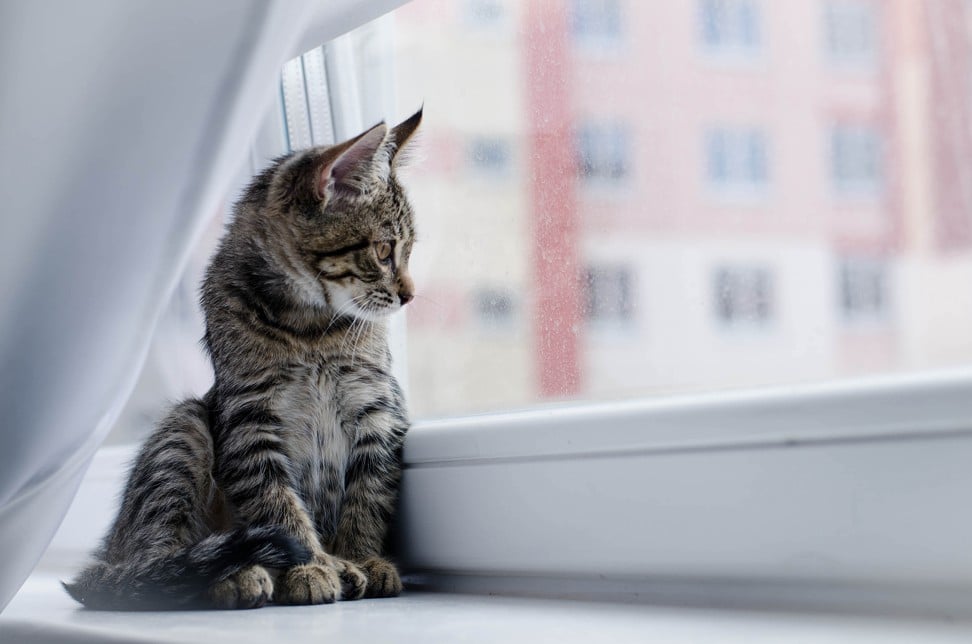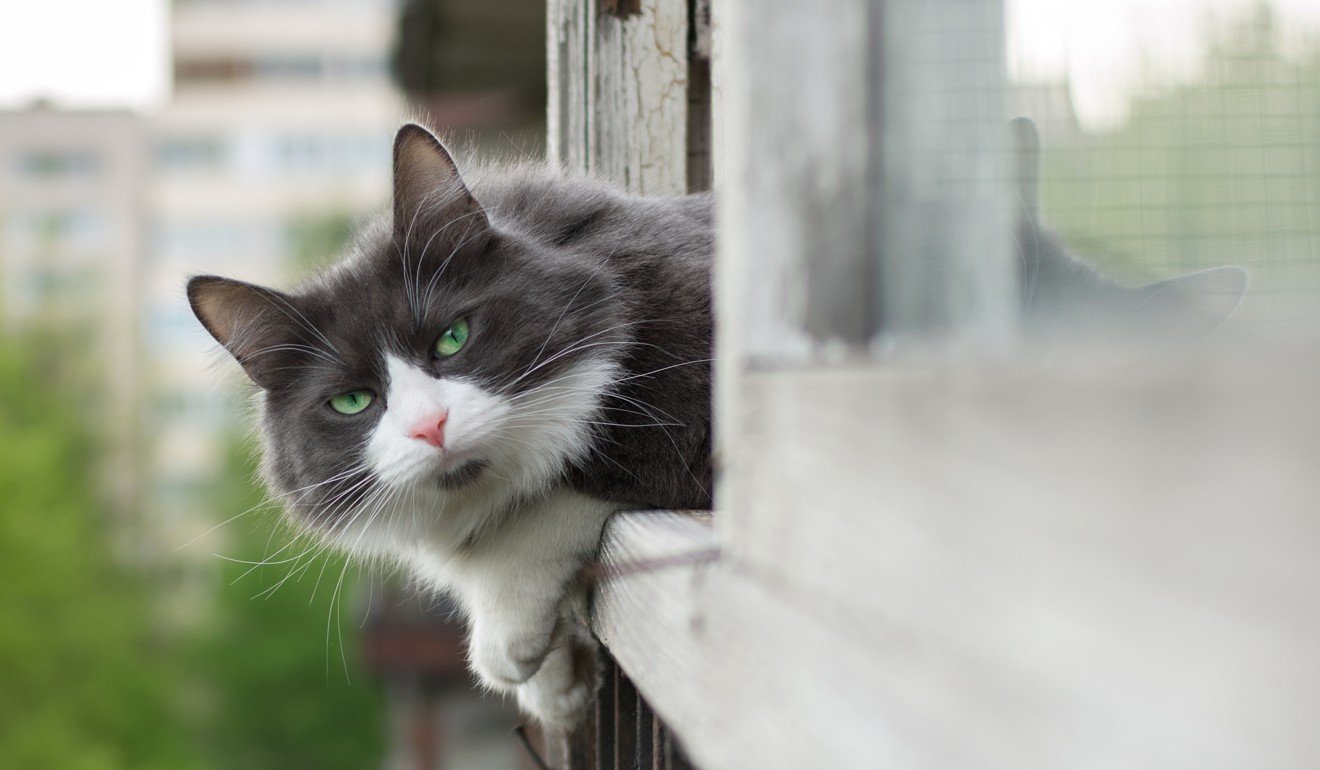
Should Hongkongers with their tiny flats own cats? Seven tips for keeping your indoor pet happy, according to experts
High-rise Hong Kong isn’t much of a cat paradise, and some question whether people should keep them locked up indoors. Here are some tips to make sure your housebound feline is feeling fine and avoid behavioural problems

When Pooja Ramchandani and her family moved from a 1,200 sq ft flat in Sheung Shui to a 700 sq ft flat closer to the city, one member of the family took it particularly badly: Gideon, their Siamese cat.
“My cat definitely suffers due to lack of space,” says Pooja, who runs the Hong Kong Pet Owners Group on Facebook. “It was fine when he was a kitten and had plenty of room in a larger flat, but now he’s an adult cat in a smaller space, he does struggle. We’ve definitely had to adapt our lifestyle for him.”

Gideon has a scratching post, lots of small toys and a series of raised beds for him to play in and hide under. Pooja even takes him out for “walks” in the corridor where he gets to run around, sniffing under every neighbour’s door. She says she would like to mount a cat playground on her living room wall, but her landlord won’t let them do any drilling.
“I think people in Hong Kong struggle to keep cats, as the lack of space usually manifests itself as behaviours that may affect our deposits, such as scratching furniture, or yowling from loneliness, which will annoy the neighbours. It’s a shame because I wouldn’t give him up for anything in the world. He’s family.”

In a city where most people live in high-rise flats, life can be tough for pets. This is especially true for cats which, according to veterinary behaviourist Dr Cynthia Smillie, have a behavioural need to go outside, patrol their territory and hunt for prey. For most Hongkongers, letting a cat out to roam and hunt is impossible – there are very few gardens. A problem in many cities, the situation is made worse by Hong Kong’s tiny flats.
Smillie is a consultant for Hong Kong’s Society for the Prevention of Cruelty to Animals (SPCA) – where cat owners can have a behavioural consultation with her – and also runs the Animal Behaviour Veterinary Practice. She explains that people often assume cats are like small dogs which, as long as they are with their owner and get regular walks, are mostly quite happy to live in a flat.
“Unfortunately, cats are not so bonded to people – they’re much more bonded to territory,” she says. “So when you confine a cat for the whole of its life in quite small flats, you’re potentially going to get a lot of behavioural issues.”
There is much debate on whether cats should be kept indoors for their own safety. No one wants their pet to be hit by a car, savaged by the neighbour’s dog or pick up a nasty disease. But keeping a cat indoors can affect it both physically and mentally. “You have to balance the risk with what the cat would choose, and most cats would certainly not choose to be in a 450 sq ft flat for 12 or 15 years of its life,” Smillie says.
Stress in cats that are confined indoors can show itself in several ways. The most common is the cat will stop using its litter tray and spray in various locations around the flat. “What they’re trying to do is make their core territory more familiar and less threatening – it’s not a case of it trying to get revenge,” Smillie says.

Cats might also display signs of compulsive behaviour, such as constantly licking themselves and over-grooming. This is a coping mechanism to reduce stress because it releases endorphins from the brain. They might also act aggressively, because they are denied the opportunity to hunt, stalk and pounce on things. This predatory behaviour might get turned towards the owner, resulting in them leaping out from underneath the sofa or clawing at their ankles.
“Unfortunately, a lot of cats are surrendered to rescue centres because of what the owner perceives to be a behaviour problem,” Smillie says.
Some owners will address these problems by assuming the pet is lonely and getting another cat. This, though, can actually add to their stress.

“Most cat owners don’t really understand that the social structure of a cat is designed to avoid interactions with other cats,” Smillie says. “If they encounter other cats it can lead to conflict. Cats don’t naturally share resources, feeding spaces or resting places.
“So if the owner brings in a new cat, it can add to the problem. If they do get another cat, they need to introduce it to the old one properly over a period of time – do things like a scent exchange, or feeding them either side of a slightly open door.”
Cats are ... bonded to territory. So when you confine a cat for the whole of its life in quite small flats, you’re potentially going to get a lot of behavioural issues
Sheila McClelland is founder and chair of LAP Lifelong Animal Protection Charity, a shelter for cats and dogs. She says that when a potential new owner for a cat is found, they will do a site visit to make sure certain requirements are met.
“Paramount is security because everywhere is high-rise and gravity is every cat’s downfall,” McClelland says. “Beyond that we look for things like have they got places to scratch, places to hide and play and climb. Then there is whether the owner has a rational attitude to litter boxes, because some people think they can just stick it where they want, but it has to be somewhere the cat will use. Most people are very willing to make changes to their lives and their homes to adopt.”

So is it really fair for Hongkongers to own cats? “I would say that cats are very well suited to be companion animals in Hong Kong as long as their needs are taken into consideration, such as through environmental enrichment,” McClelland says.
For Smillie, it is a difficult question to answer. “I go to a lot of clients where the cat is living in a small flat and is actually very successful. I think people have to look at their lifestyles and what they can provide. If they’re aware of and can provide what the cat needs in terms of behaviour, and they’re prepared to spend time with it, play with it, and temperamentally the cat is suited, then it can be a very successful relationship between the cat and the owner.
“But for lots of cats, it isn’t really such a great life. And because a lot of people see a cat as an easier option than a dog, I think it comes as a bit of shock to them when they realise it’s not a straightforward as they thought.”
Smillie’s seven ways to de-stress an indoor cat
1. Do the research
“First of all, cat owners should read up on cats’ normal social structure so that they understand what a cat needs and don’t have misconceptions about their behaviour. What the owner perceives as a behaviour problem is probably normal behaviour for the cat that may be inappropriate in that situation.”
2. Enrich the indoor environment
“Cats like high resting places, so give them plenty of options. They like lower resting boxes, somewhere for them to scoot into and hide. Scratching posts are also good – scratching isn’t just for sharpening the nails but is a behavioural need that helps mark a territory and makes it feel familiar.”
3. Give them options
“Cats don’t always like to have just one place to eat, so maybe give them two food stations and two water bowls they can choose. Providing more than one litter tray can definitely help – place them in quiet areas away from the busiest parts of the house.”
Cats are very well suited to be companion animals in Hong Kong as long as their needs are taken into consideration
4. Play with them
“Fishing toys, feathers and laser pointers all allow the cat to engage in hunting-like activities. It is even better if play is scheduled at times when a cat would naturally be out hunting – early in the morning and early evening. Cats don’t really need long periods of play – they get bored after a fairly short period – but giving them several short play sessions may be enough to satisfy them.”
5. Puzzle activity feeding
“In the wild, cats would make maybe 100 attempts to catch something, but succeed only 10 per cent of the time. There’s a lot of mental stimulation and physical effort in that. Try to think about ways to replicate this, like putting dry food in activity feeders or in things like old toilet rolls, cardboard egg cartons, anything to try and mentally stimulate the cat so it is engaged in these activities during the day.”

6. Make use of outdoor areas
“Often people have rooftops or balconies. Cat-proof it, put in things like pot plants with some grass that the cat can eat, get a log for it to scratch, things that hang down, anything that will give the cat some interest and activity.”
7. Get a pheromone plug-in
“Pheromone therapy is very useful to reduce stress in a flat and has been scientifically proven to reduce cortisol stress levels in the blood. You can buy something like Feliway, which you just plug in and creates this feeling of security in the cat’s core territory.”